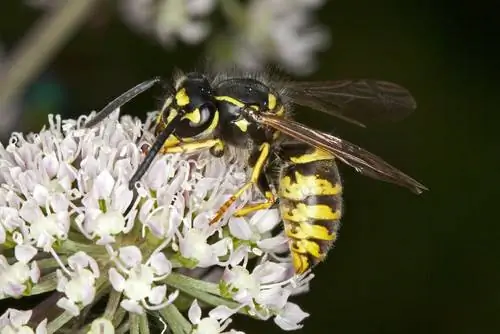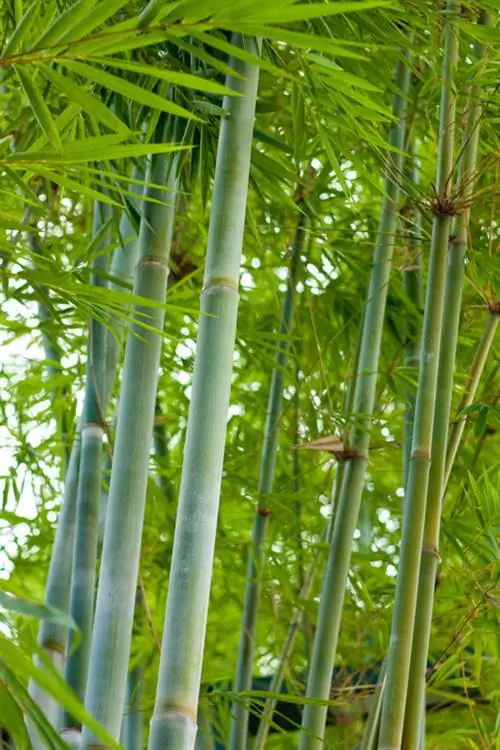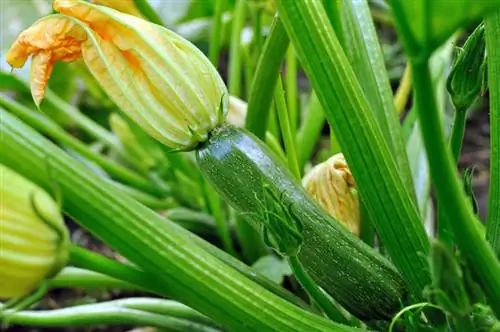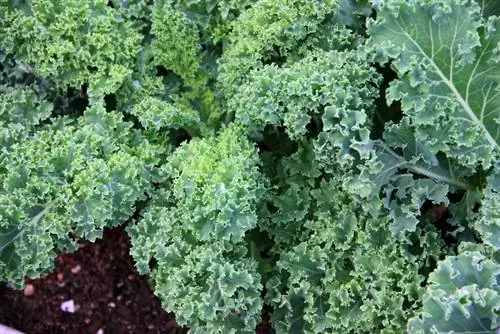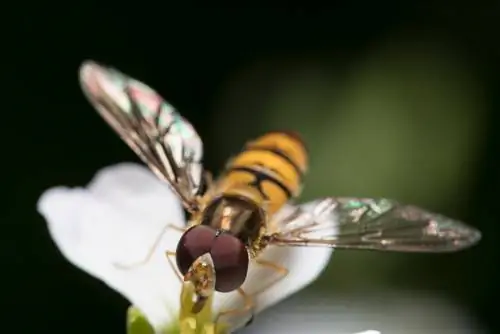- Author admin [email protected].
- Public 2023-12-16 16:46.
- Last modified 2025-06-01 06:02.
Most people are afraid of wasps because they are considered aggressive and stinging. The common wasp is one of the species that can be intrusive to humans. However, she doesn't go on the attack without reason.
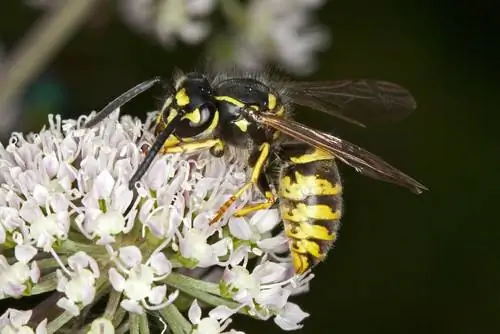
How do I behave towards the common wasp?
The common wasp (Vespula vulgaris) is a common and important species in Central Europe that fights insects and collects nectar. It is peaceful unless threatened and cannot be killed according to conservation law. To successfully keep wasps away, use strong smells such as coffee, essential oils or lemons with cloves.
Profile
The common wasp (Vespula vulgaris) is one of the short-headed wasps and, along with the German wasp, is one of the wasp species that are very common in Central Europe. At first glance, Vespula vulgaris can hardly be distinguished from its sister species. Both species follow similar lifestyles.

Recognize
The common wasp is characterized as a short-headed wasp by the small distance between the lower edge of the eye and the pine claws. These so-called mandibles are located directly below the compound eyes, which is why the cheeks are almost completely missing. Like all real wasps, the abdomen of this species is yellow-black, although the ringing can vary between individuals.
Size of each individual:
- Queen: between 16 and 19 millimeters
- Workers: from eleven to 14 millimeters
- Male: between 13 and 17 millimeters
Lifespan
The state is founded by a queen in the spring. She has overwintered from last year and will produce numerous offspring in her last year of life. The head can live for around 14 months, while the workers die after six months. Males hatch in late summer and do not overwinter, so they live shorter lives than workers.
Differences common wasp, German wasp and others
The appearance of Vespula vulgaris is similar to the appearance of other species native to Europe. But not all wasps live near people. Most species are peaceful and shy. They inhabit species-rich landscapes with a rich supply of nectar.
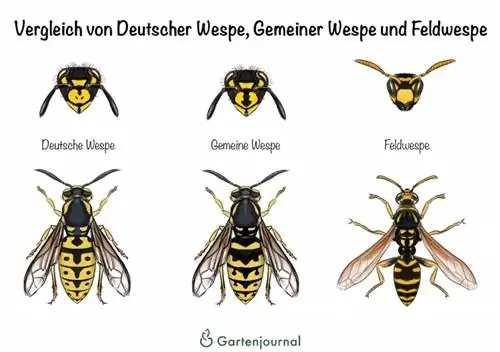
| Special features | Features | |
|---|---|---|
| Common wasp | one of the most common wasp species | Front plate with line |
| German wasp | underground nests, like to be close to humans | Front plate dotted or dashed |
| Austrian cuckoo wasp | Red Wasp Parasite | Front plate completely yellow or dotted |
| Red Wasp | she avoids being close to people | anterior abdominal segments red |
German Wasp - Difference
The abdomen pattern does not provide any information about the respective species, as it can be extremely variable. To separate the species from each other, you should take a closer look at the head. The common wasp has a typical marking on the forehead plate, which distinguishes it from the German wasp. The broad black line, which thickens towards the bottom in a club shape, is characteristic. Here the German wasp usually has three dots, some of which can merge into one line.
Fighting common wasps
Insects of all kinds are threatened with extinction. The common wasp is not (yet) an endangered species and it would be nice if it stayed that way. Therefore, you should definitely refrain from killing wasps. Combating it is also unnecessary in most cases. However, there is a need for action if you notice a wasp nest in the roller shutter box or a swarm of wasps attack your afternoon table in the garden. Wasp nests in sensitive locations can be removed by a professional. If there are wasps on the cake, there are several ways to drive away the voracious insects:
- Offer them an alternative food source away from your coffee table
- Place several sliced oranges or lemons with cloves, wasps and other insects can't stand the smell
- Essential oils such as clove oil, tea tree or citronella keep the wasps away
- Wasps don’t like the smell of coffee either
- Incense sticks or burning coffee powder repel wasps
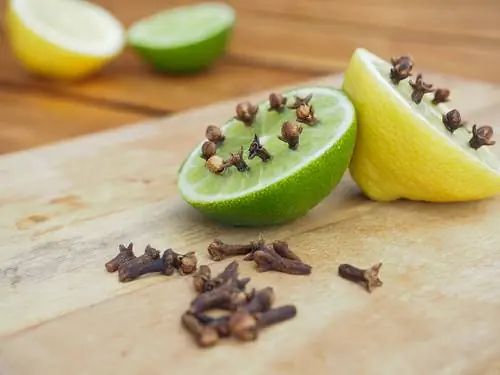
Cloves and citrus smells keep wasps and mosquitoes away
Lifestyle
Contrary to what many people assume, the common wasp is comparatively peaceful. Workers defend themselves outside their nest when disturbed or threatened. Their aggressive behavior increases the closer the distance to the nest is. Dark clothing reminds the animals of a potential predator, against which defensive measures are quickly taken. An alarm pheromone informs conspecifics of the threat.
The venom of the wasp is hardly more dangerous or painful than that of bees and bumblebees.
Food
Adult wasps feed primarily on plant-based food such as nectar and sugary juices. When the queens are looking for a suitable nesting site in April, they feed on nectar from early flowering plants such as willows. The smell of sweets is seductive. Once wasps have discovered sweet drinks and cakes as a source of food, they can hardly be driven away. Larvae are fed a mash of chewed insects rich in animal protein.
- Carbohydrates: plant juices, nectar, honeydew
- Protein: insects, carrion, meat
Attack and Defense
Wasps have a stinger that they use to overwhelm and paralyze their prey or ward off enemies. However, only queens and workers are able to sting because the males have no stinger.
Normally the stinger is at rest and hidden in a chamber. When an attack occurs, the stinger is extended. The wasp holds on with its legs and pushes the stinger into the organism. She sets her stinging bristles in motion, which dig ever deeper into the skin and drag the entire stinger with them.
Wasps are able to sting multiple times thanks to their special sting structure. In their case, the stinger does not break off because it can be pulled out of the skin again due to the lack of barbs on the stinger sheath. Even dead or dismembered animals can still sting because the process is triggered by a reflex.
Structure of the stinger:
- two movable piercing bristles with barbs
- Spiny groove with channel to the poison gland
- Sting sheath different from that of bees without barbs
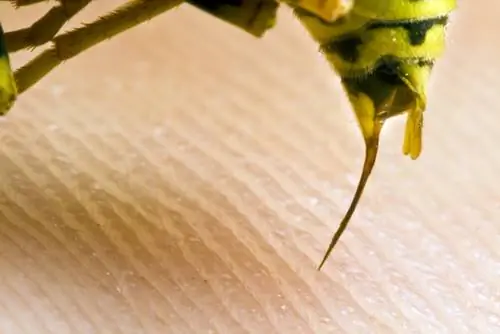
Wasps sting when they feel threatened
Excursus
Poison components and effects
Various components have been found in wasp venom, including histamine and serotonin, acetylcholine and free amino acids as well as proteins and enzymes. Wasps inject between two and ten micrograms of venom into the organism per sting. The stings of wasps, hornets, bumblebees or bees are almost equally painful because they are made up of similar components.
In he althy people, the poison causes swelling and redness, which can be painful. However, the symptoms disappear after a short time. Various enzymes are the main allergens and cause dangerous body reactions in allergic people.
Development
The common wasp is also known as the earth wasp because of its way of life. The wasp nest is preferably built underground, with the animals also settling in dark corners and protected niches in attics, shutter boxes or barns.
Nest building
The queen begins building her nest from mid-April. She collects wood fibers from weathered wood and rotting tree trunks, which she chews into a sticky mass. This material gives the wasp nest a light beige color. The nest is preferably built in a dark and protected place. Abandoned mouse and mole burrows underground are often used. As the colony grows, additional underground tunnels are dug and the nest is expanded.
Nest building:
- Six additional cells are built around a central brood cell
- hanging upside down from the cave ceiling
- surrounded by spherical nest cover
Foundation of the state
After the queen has completed construction, she lays an egg in each brood cell. Shortly before laying her eggs, fertilization occurs with seeds that she has stored since mating last fall. At this time the queen is still on her own and has to look after the brood and look for food. When the larvae hatch, she feeds them an insect pulp. The larvae release a drop of fluid rich in sugar that serves as food for the queen.
Larval development
Shortly before the larvae pupate, they empty themselves completely and for the first time by releasing feces. This will prevent the nest from becoming dirty and the excrement from rotting. The queens emit pheromones that influence the development of the larvae. In early summer, sterile workers emerge from these, which take over the tasks previously carried out by the queen. The queen is then responsible for reproduction.
Development of the state
During the summer months the nest grows continuously. Under optimal conditions, a state can accommodate between 3,000 and 4,000 individuals. The maximum size is reached when new sexually mature animals hatch in late summer. The queen reduces the pheromone release so that new young queens are created. The larvae develop in special brood cells that are slightly larger than conventional chambers. Males hatch from unfertilized eggs. During the rest of the year no new workers are created and the number of individuals drops rapidly.

Several thousand wasps live in a wasp nest
Wintering
Males leave the nest very quickly to search for females from other states to mate. They die shortly after mating. The old queen also dies in late autumn, causing her state to completely dissolve. The workers no longer have a job and become homeless. They die when the cold sets in, while the young queens retreat to sheltered winter quarters. Here they fall into hibernation until next spring.
Young queens overwinter here:
- rotten wood
- under bark and moss
- in protected cavities
Nature conservation
Like all wild animals, the common wasp is subject to the Federal Nature Conservation Act. According to Section 39 Paragraph No. 1, it is forbidden to catch, injure or kill animals without a special reason. The protection status also applies to the nesting sites. Although wasps are not subject to special protection like bumblebees, wild bees and hornets, you should not remove or destroy a nest for no reason. An expert can assess whether there are sufficient reasons for removal or relocation.
Tip
It is better to hire an expert to remove a nest. Otherwise you risk a fine, which in most federal states is 5,000 euros.
Wasps in the garden
If wasps have chosen your garden, you can be happy about the useful helpers. Wasps are better than their reputation. Follow a few rules so that you don't endanger yourself unnecessarily and can live peacefully with the insects.
Useful
Wasps take on important functions in the ecosystem because they keep the populations of annoying mosquitoes, horseflies and plant pests such as aphids in check. The insects are considered insect killers because they have to capture large quantities of proteins to raise their larvae. Wasps capture around 500 to 2,000 grams of insects per day. Occasionally the wasps can also be observed on dead animals from which they collect the meat. In this way, wasps ensure faster carrion utilization.
Ecological benefits of the German wasp:
- Food supplier: for birds and shrews
- Destruent: accelerates the decomposition of dead trees
- Pest control: in the forest and garden
Peaceful coexistence
Give wasps an undisturbed place in the garden that is far enough away from your coffee table. Provide wasps with alternative quarters. The animals settle in gazebos and roller shutter boxes if they cannot find suitable nesting opportunities in nature. A simple wooden box with entry holes ensures the wasps a safe shelter. Place this in a secluded corner of your garden.
How to build a simple insect hotel:
- Base: Hardwood block
- Processing: drilling gears with different drills
- Suspension: sunny place
Tip
If you have been stung by a wasp, you should change your clothes. This could smell of the wasps' alarm pheromones and trigger another attack.
Frequently asked questions
Can the common wasp sting multiple times?
Wasps have a special sting structure that allows them to sting multiple times. While bees have barbs on their sting sheaths, the sheath surface of a wasp stinger is smooth. This allows her to pull the stinger out of the skin again. This is also made easier by muscles that are located at the base of the spine and anchor it firmly in the body. The sting reflex is still present even in animals that have just died or been cut up, so that they can still sting.
What to do with a wasp nest?
If there is no immediate danger, you can leave nature to its own devices. The wasp colony dies out in the fall and the overwintering young queens do not use the old nest again. You can remove this in winter when there are no more wasps in it. If there is an immediate danger from the wasp nest, you can contact a specialist. NABU and LBV are the first points of contact where you can get help. There are also special wasp advisors.
How can I keep wasps away?
Make sure that no fallen fruit is left lying around in the garden. Wasps are magically attracted to it. Harvest the fruit early. Also avoid dark clothing, as this acts as a potential predator to wasps and encourages them to attack.
Species-rich flower meadows also attract wasps. Instead of mowing the entire lawn, you should make your garden more structured. Leave a strip of wild plants and mow only part of the lawn. The flower border should be in an area away from the terrace, balcony or other seating options.
How dangerous is a wasp sting?
Even though many people are afraid of a wasp sting, it is no more dangerous than a sting from a bee or bumblebee. The components are very similar. Wasps inject between two and ten micrograms of venom per sting. In the majority of people, the reddened bite site swells, which can cause pain and itching. The symptoms automatically subside after a few hours. When people have an allergic reaction, life-threatening symptoms can occur. These reactions are caused by various enzymes in wasp venom.
What helps against a wasp sting?
Cool the bite with ice or a cooling pad to relieve the pain and relieve itching. Onions are a tried and tested remedy for wasp stings. The juice cools and has an anti-inflammatory effect at the same time. You can also neutralize the poison by pressing a poultice of cold vinegar onto the sting site.

